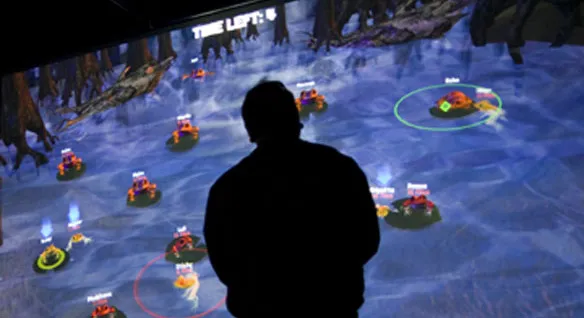A physically interactive social game to teach youth the value of their actions to make a difference in the world
The Illinois Holocaust Museum and Education Center hired Inquirium to conceive, design, and implement a learning environment to teach children aged 9-11 the universal lessons of the Holocaust, as part of its launch in Skokie, Illinois.

Client:
Illinois Holocaust Museum and Education Center
Funder:
Client-funded
Challenge
How do you help a 5th grader understand and care about the holocaust without going into the horrors? The museum’s founders, who were themselves Holocaust survivors, were interested in teaching young kids the universal lessons of the Holocaust, as an alternative to the traditional historical approach.
Solution
We combined motion tracking with an engaging game environment to create an opportunity for kids to engage in social interactions that challenge them to observe, make choices, resist negative forces, and help others. The allegorical fantasy setting provided a safe space to explore roles and identities as they learned to take a stand against bullies.
Learn More...
The Storyline:
When you enter the pond, you become a yellow frog in a community of red and yellow frogs. The pond starts as an idyllic place, with frogs swimming around, hopping on lily pads, and catching flies. The easy-going music conveys a relaxed and peaceful environment. The apparent goal is to catch as many flies as you can. Some players may choose to cooperate with the red frogs, others might view them as competition for flies.
A large frog, different from the others, enters the pond. Ominous music signals that something is about to happen. As the large frog surveys the scene, its compatriots assemble at the edge of the pond. The large frog begins to glow as it targets a red frog. Perhaps this a good thing, giving me an edge over the red frogs? Or perhaps this is aggressive behavior that should be stopped.
You can choose to help the large frog target the reds or to defend the reds by resisting the large frog. If you bump the large frog right away, it “calms down.” If you do nothing, the large frog becomes more aggressive, and soon its friends start enter the pond, causing more chaos. If you remove a large frog from its pad, it will go away, but not before targeting me in retaliation.
Depending on how you act, the pond may change significantly, spiraling into chaos as the large frogs begin to take over, or remaining in an uneasy calm as the large frogs remain at bay.
Throughout the experience, nothing is told; you must notice the unfolding events themselves. There are different possible endings, but regardless of the outcome, the pond becomes a much different place.
The Learning Experience:
Take a Stand is designed to be a facilitated experience involving two rounds of play and supported by docent-led discussion following each round. For instance:
- First play (about 3 minutes)
- Discussion, focusing on who the characters are, what happened, and what you would do differently.
- Second play (about 3 minutes)
- Discussion, focusing on what we can take away from the experience.
Through iterative play and reflection, participants gain a deeper understanding of their virtual world, the characters that inhabit it, the actions that impact the pond, and the steps they can take to make it a better place.
The Technology:
Inquirium has developed a one-of-a-kind technology that tracks the motions of participants in a 20x20 space in order to control objects on a giant 18 foot screen. Through your movements, you can control virtual characters (in this case, frogs on lily pads) as they hop around and catch flies. No wearable sensers or devices are required. Simply enter the space and start movning around.
The virtual environment provides a number of social challenges that compel kids to work together, deal with scarcity, help others, and witness the impacts of their decisions. Kids engage with peers and strangers alike to solve challenges within the environment.
Results
Inquirium was initially invited by the museum to help create a vision for the entire Youth Exhibition, working hand in hand with museum consultants (including Disney Imagineers).
We were then invited to design—and later to produce and build—the featured “Take a Stand” experience. Our work included architecting the physical space and audio visual system, and creating the motion tracking architecture, narrative experience, animation & 3D graphics, soundtrack, and gameplay. Inquirium also developed professional development for the docents.
During a 10-year run, our “Take a Stand” experience was an integral facet of the museum’s Harvey L. Miller Family Youth Exhibition. Countless students participated in docent led experiences, either through school field trips or with their families.